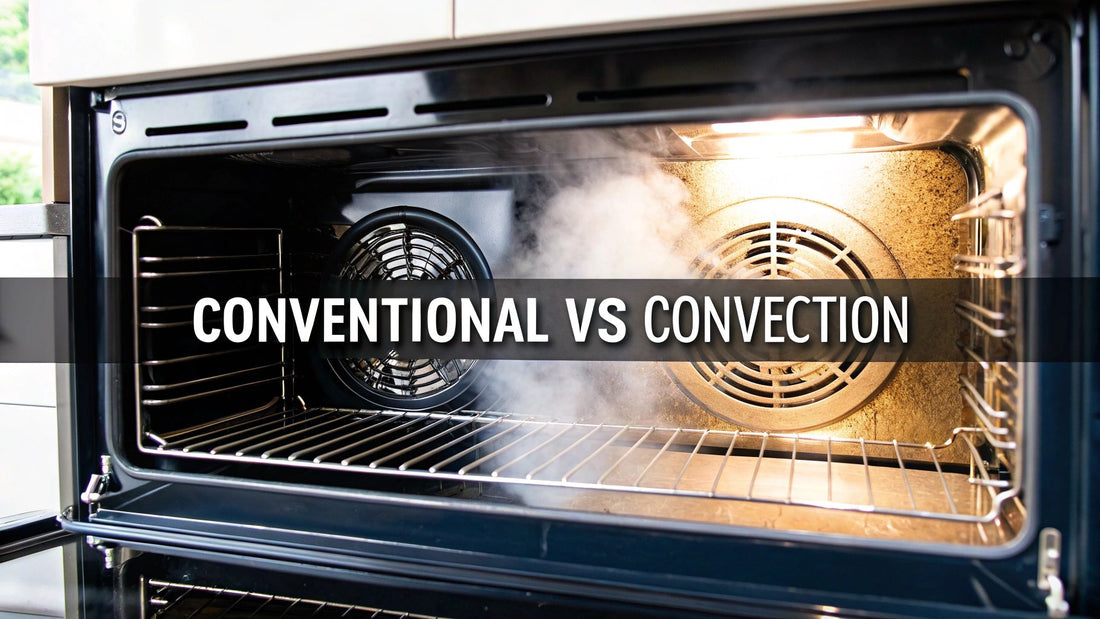
Conventional Oven vs Convection Ovens
Share
When you're trying to decide between a conventional and a convection oven, it all comes down to one thing: airflow. A conventional oven cooks with static, radiant heat coming from elements at the top and bottom. A convection oven, on the other hand, adds a fan to circulate that hot air. It’s a simple mechanical difference, but it completely changes how the oven performs. That fan makes a convection oven faster and more consistent, which is why it's a workhorse for roasting and multi-rack baking in a busy restaurant.
Choosing the Right Oven for Your Kitchen
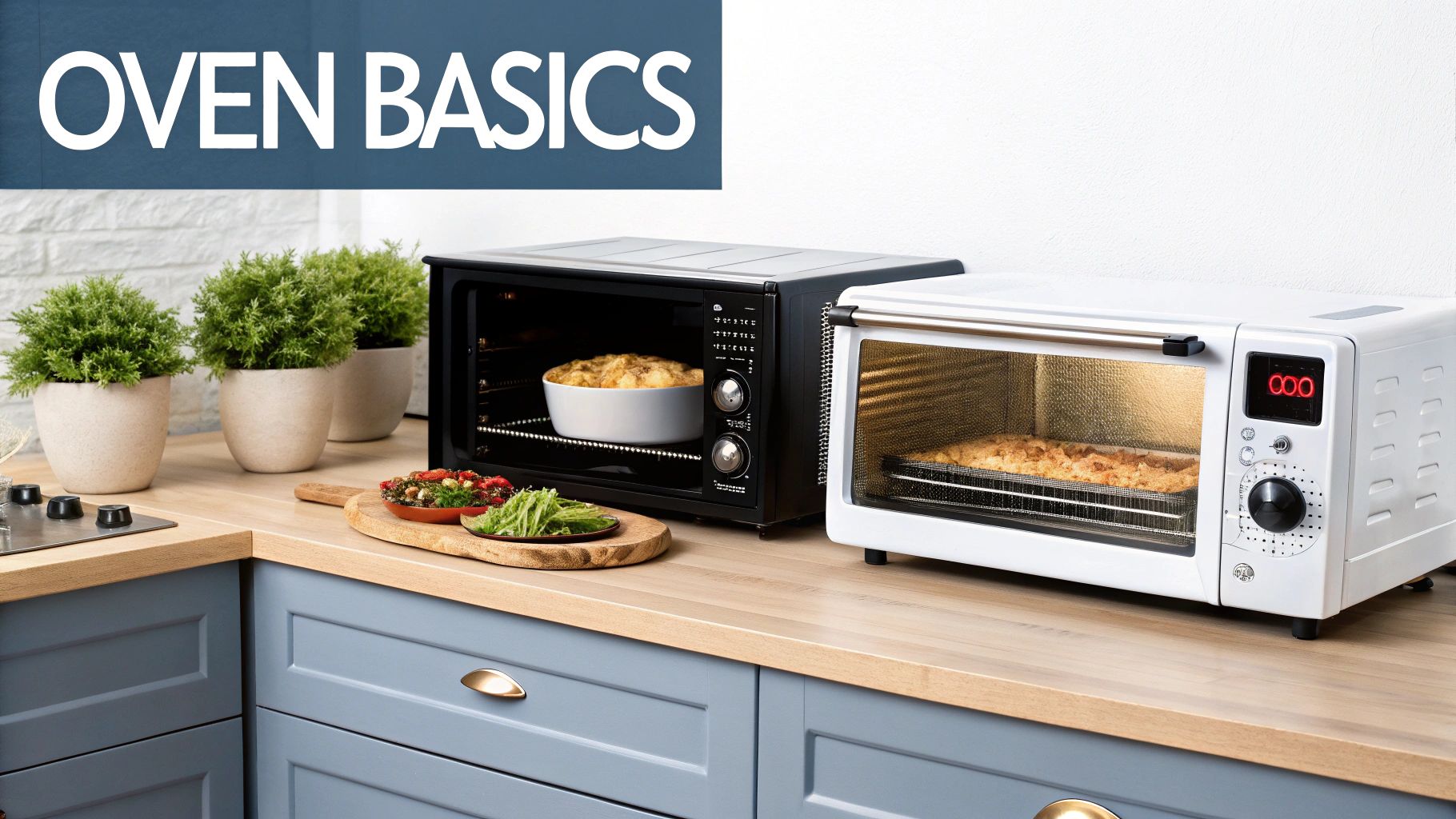
Picking out a commercial oven isn't just another purchase; it's a major investment that has a direct impact on your food quality, your kitchen's workflow, and ultimately, your profits. The choice between a conventional and a convection model is one of the first big decisions a chef or owner has to make, because each oven really shines in different situations and for different types of food.
Getting a handle on that core difference—static heat versus circulated heat—is the key to staying informed about industry trends. That single distinction affects everything: cooking times, energy bills, and even the final texture and browning on your dishes. Making the right call here means your kitchen will have the tools to push out consistently great food, day in and day out.
Fundamental Differences at a Glance
Before we get into the nitty-gritty, a side-by-side look can really help clarify things. This table breaks down the core functions of each oven type, giving you a quick reference for the more detailed analysis to come.
| Feature | Conventional Oven | Convection Oven |
|---|---|---|
| Heating Method | Uses static heating elements at the top and bottom for radiant heat. | Uses heating elements plus a fan to move hot air all around. |
| Heat Distribution | Tends to have hot and cold spots, often requiring you to rotate pans. | Delivers consistent, even temperature throughout the entire cavity. |
| Cooking Speed | Follows standard cooking times you see in most recipes. | Cooks up to 25% faster and at lower temperatures. |
| Best For | Delicate foods like custards, soufflés, and certain cakes that can be ruined by moving air. | Roasting, baking on multiple racks, and getting that perfect crisp, brown finish. |
The real question isn't about which oven is "better" in general, but which one is better for your menu. A high-volume bakery has totally different needs than a fine-dining kitchen focused on delicate pastries.
This guide is designed to help you think past the spec sheets. We want to frame the conventional vs. convection debate as a strategic decision tied to what you're actually trying to cook. Outfitting your kitchen is a big job, and using a comprehensive commercial kitchen equipment checklist can make sure nothing gets overlooked. By understanding what makes each oven tick, you can choose a reliable piece of equipment that will help you deliver the best possible results to your customers.
How Each Oven's Heating Technology Works
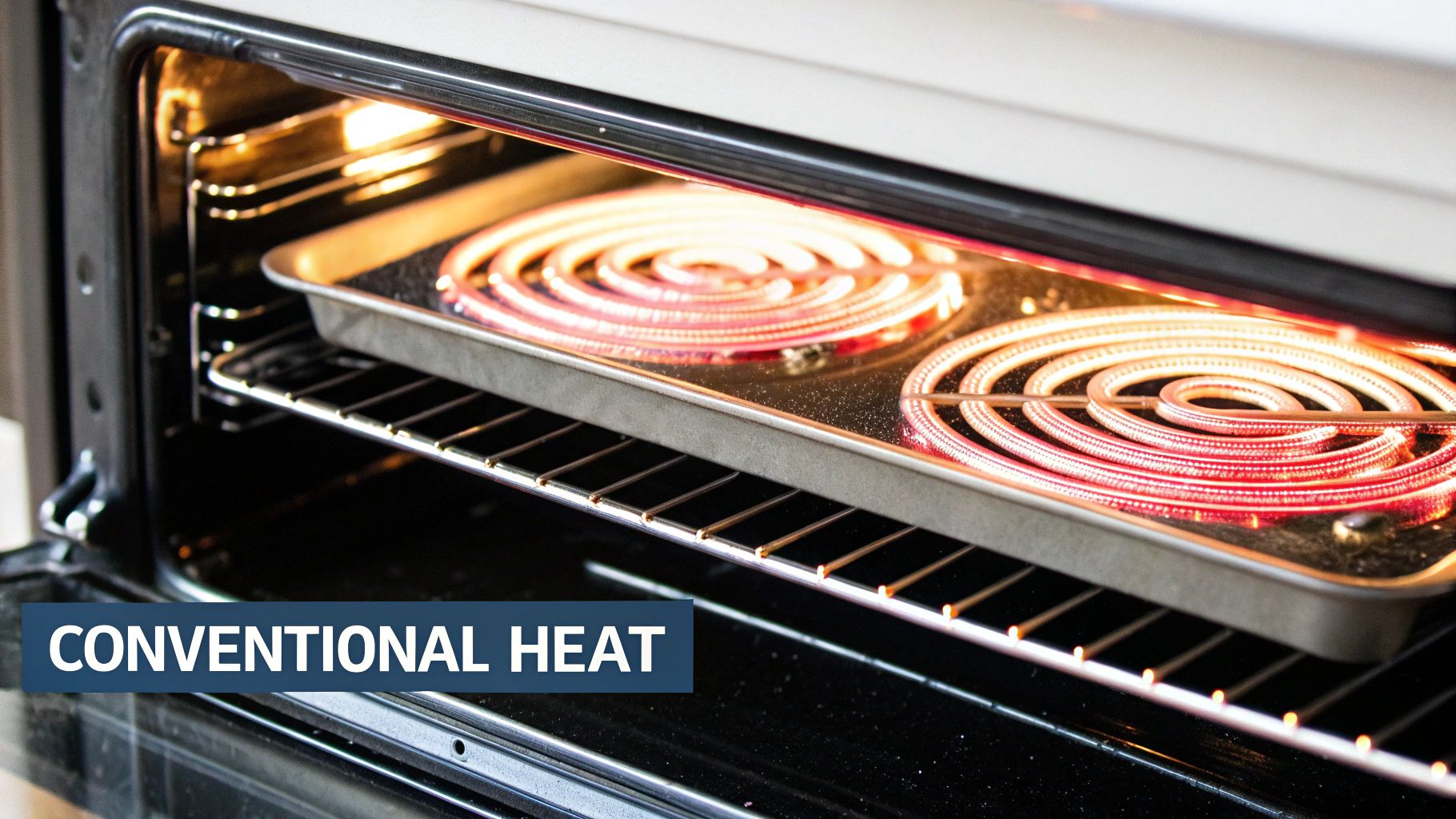
Before you can settle the conventional vs. convection oven debate for your kitchen, you have to get to grips with how they actually cook. At a glance, they look similar, but the way they transfer heat to food is fundamentally different. It's this difference that dictates everything from cook times to the final texture and color of your dishes.
One oven creates a quiet, still environment, while the other whips up a storm of circulating hot air. Understanding the mechanics isn't just a technical exercise; it's the key to matching the right restaurant equipment and supplies to your menu and workflow.
The Static Heat of a Conventional Oven
Conventional ovens are the classic workhorses. They operate on a simple principle: static radiant heat. The heating elements, usually found at the top and bottom of the oven cavity, get hot and radiate that heat into the box. It’s a lot like sitting near a campfire—the heat just flows from the source outward.
This creates a very still, layered thermal environment. Since heat naturally rises, the top of the oven becomes the hottest spot, which is perfect for browning the top of a gratin. The bottom rack gets blasted with direct heat from the lower element, ideal for getting a crisp pizza crust. But this also means the middle of the oven can be a bit of a wild card, with hot and cool spots that demand your attention.
It’s a gentle, undisturbed heat that works beautifully for delicate cakes or soufflés that need to rise slowly and evenly.
Key Takeaway: With a conventional oven, rack position is everything. You're not just putting food in the oven; you're placing it in a specific heat zone. This often means rotating pans halfway through cooking, especially if you're trying to use more than one rack at a time.
The global oven market, which includes both types, is expected to grow from USD 17.25 billion in 2025 to USD 26.38 billion by 2034. A huge chunk of that market still belongs to conventional ovens, largely because they are simple, familiar, and cost less upfront. You can find more insights about oven market projections and what's driving this growth online.
The Dynamic Airflow of a Convection Oven
A convection oven starts with the same basic heating elements but adds a critical piece of hardware: a fan. This fan, along with an exhaust system, is a complete game-changer. It pulls the air in, forces it over the heating elements, and then blasts that superheated air all around the oven cavity. This is forced hot air circulation.
That fan is constantly moving the air, breaking up the bubble of cooler air that naturally surrounds food in a static oven. The result is a consistent, even cooking environment from corner to corner and rack to rack. It effectively eliminates the hot and cold spots you fight with in a conventional model.
For a busy commercial kitchen, this dynamic airflow translates into some serious advantages:
- Faster Cooking: Food cooks up to 25% faster because the heat transfer is so much more efficient.
- Better Browning: The circulating air accelerates the Maillard reaction, giving you that beautiful, deep-brown color on everything from roasted chickens to dinner rolls.
- Crispier Results: The fan helps pull moisture away from the surface of food, leading to perfectly crispy chicken skin and flaky pastries.
Put simply, a convection oven creates a more intense and reliable cooking environment. It’s the go-to for high-volume roasting, baking sheet after sheet of cookies, or anything that needs to be perfectly and consistently cooked in large batches.
Performance and Efficiency Comparison
When the dinner rush hits, every minute and every degree counts. The real debate between a conventional and a convection oven boils down to how they perform under pressure. These aren't just abstract specs on a product sheet; they directly shape your kitchen's output, the consistency of your food, and your bottom line.
A closer look at cooking speed, temperature reliability, and energy use reveals some major differences. For any restaurant owner, understanding these metrics is the key to seeing the real-world impact of their oven choice. It’s not just about cooking food—it’s about optimizing your entire workflow and keeping costs in check.
This image breaks down the core differences in airflow and how that affects cooking time and temperature stability.
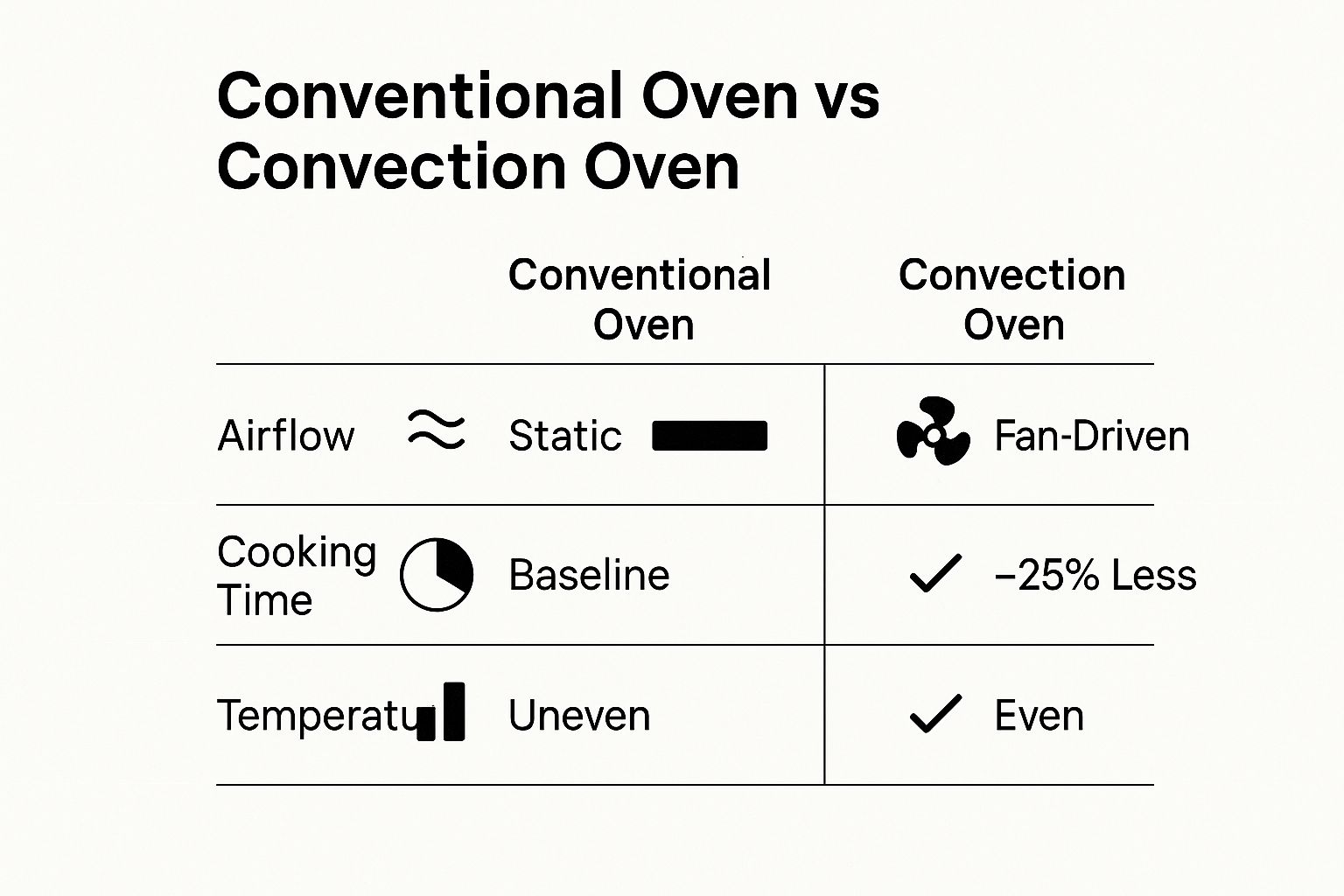
You can see right away how the fan-driven airflow in a convection oven creates a faster, more even cooking environment compared to the static heat of a conventional model.
Cooking Speed and Throughput
The most talked-about advantage of a convection oven is its speed. The constantly circulating hot air is a game-changer. It strips away the cool air that naturally surrounds food, transferring heat much more effectively and slashing cooking times.
A convection oven can cook food up to 25% faster than a conventional oven. For a busy kitchen, this isn't a small perk—it means higher throughput, quicker ticket times, and the ability to serve more customers when it matters most.
Think about it this way: a tray of roasted vegetables that takes 40 minutes in a conventional oven might be perfectly browned and tender in just 30 minutes with convection. That efficiency is a huge deal when you’re turning tables or handling a big catering order.
Temperature Consistency and Multi-Rack Cooking
This is where the practical differences really shine in a high-volume kitchen. Conventional ovens are infamous for hot and cold spots because their heating elements just radiate heat from one place. This forces chefs to constantly rotate pans to get an even bake.
Convection ovens completely solve this problem. That fan ensures a uniform temperature throughout the entire oven cavity, which delivers two massive benefits:
- Predictable Results: Every corner of the oven cooks at the same rate. This takes the guesswork out of baking and roasting, ensuring your dishes come out right every single time.
- Multi-Rack Efficiency: You can load up multiple sheet pans on different racks and trust that they will all cook evenly, no shuffling required. A bakery can bake three racks of cookies at once and have them all come out with the same perfect color and texture.
This multi-rack capability is a massive boost to an oven's capacity, letting your kitchen produce more food without taking up more floor space.
Browning and Crisping Capabilities
The final look and feel of a dish are what make it truly appealing, and this is another area where convection ovens excel. The circulating hot air is fantastic at wicking moisture away from the food's surface, which powerfully promotes the Maillard reaction—that wonderful chemical process that gives roasted meats, bread, and vegetables their delicious brown crust.
Conventional ovens can get you there, but they often need higher temperatures or longer cooking times to achieve the same crispiness. This can be a balancing act, sometimes leading to an overcooked interior just to get the outside perfectly browned. A convection oven gives you that beautiful golden-brown finish while keeping the inside perfectly moist and tender.
Let's break down the key performance differences in a simple table. This helps visualize how each oven type stacks up in the metrics that matter most for a professional kitchen.
Key Performance Differences Conventional vs Convection Ovens
| Performance Metric | Conventional Oven | Convection Oven |
|---|---|---|
| Cooking Speed | Slower; relies on static radiant heat. | Up to 25% faster due to fan-circulated air. |
| Temperature | Prone to hot and cold spots. | Highly consistent temperature throughout the cavity. |
| Evenness | Requires rotating pans for even results. | Cooks evenly across all racks; no rotation needed. |
| Capacity | Limited multi-rack use due to uneven heat. | Excellent for multi-rack cooking, boosting throughput. |
| Browning | Good, but can be slow and uneven. | Superior browning and crisping. |
| Energy Use | Less efficient; longer cook times and higher temps. | More efficient; cooks faster at lower temperatures. |
This side-by-side view makes it clear: for kitchens focused on speed, consistency, and volume, the convection oven has a distinct advantage across the board.
Energy Consumption and Long-Term Costs
Efficiency isn't just about time; it's also about energy. Because convection ovens cook food 25% to 30% faster and at lower temperatures, they lead to some serious energy savings. A recipe that calls for 60 minutes in a conventional oven might be done in 45 minutes in a convection model, directly cutting down on your gas or electricity bill.
While a convection oven often has a higher upfront price, the long-term savings on utilities can be substantial. When you combine those savings with the increase in productivity, you'll often find it has a much lower total cost of ownership over its lifespan. Of course, keeping that efficiency high depends on good upkeep, and you can learn how to master commercial kitchen equipment maintenance with our in-depth guide.
Matching the Oven to Your Menu
All the tech specs in the world don't mean much if the oven can't handle your menu. What works perfectly for one dish can absolutely ruin another. When it comes down to the conventional vs. convection oven debate, the decision should always circle back to the food you’re actually making. Each oven creates a distinct cooking environment, and you need to match that environment to your recipes.
Think of it this way: one oven offers a gentle, still heat that’s perfect for delicate work, while the other brings a powerful, circulating heat that’s a master of browning and crisping. Let's dig into which oven is the right tool for specific jobs, using real-world kitchen scenarios as our guide.
When to Stick with a Conventional Oven
The biggest strength of a conventional oven is its gentle, undisturbed heat. Without a fan blowing air around, you get a calm environment where delicate batters can rise and set properly without drying out or getting pushed around. This makes it the only real choice for certain types of baking where a tough crust or super-fast cooking would be a disaster.
A conventional oven is your best bet for:
- Delicate Desserts: We're talking about cheesecakes, custards, flans, and soufflés. These are high-moisture items that need to set slowly and evenly. The fan in a convection oven is notorious for making them crack, fall, or dry out on top.
- Quick Breads and Spongy Cakes: Things like banana bread, pound cake, and delicate sponge cakes really need that static heat. The still air gives the leaveners time to do their job, creating a tender, moist crumb instead of a prematurely hardened crust.
- Covered Braises: If you’re slow-cooking a pot roast or short ribs in a covered Dutch oven, the intense circulating air of a convection oven is just overkill. The simple radiant heat from a conventional oven is all you need to get the job done beautifully.
A fine-dining spot known for its intricate pastries absolutely needs a conventional oven. That precise, gentle heat is the only way to get the perfect texture on a crème brûlée or make sure a soufflé rises tall without collapsing.
When a Convection Oven Is a Must
For speed, browning, and sheer efficiency, nothing beats a convection oven. That fan circulates hot air, creating an intense, consistent cooking environment that's a godsend for any high-volume kitchen that does a lot of roasting, toasting, or batch baking. It’s the king of crispy textures and beautiful, even color.
This is your go-to machine for:
- Roasting Meats and Poultry: That fan is a genius at rendering fat and crisping up skin. A whole chicken, a prime rib, a tray of vegetables—they all come out with a deep, golden-brown exterior while staying juicy inside. And it gets done a whole lot faster.
- Batch Baking Cookies and Pastries: For any bakery or café pumping out dozens of cookies, scones, or croissants, this is a game-changer. You can load up multiple trays at once and know they’ll bake evenly without you having to constantly rotate pans. Every single item comes out looking perfect.
- Dehydrating and Toasting: The dry, circulating air is ideal for making things like fruit chips or beef jerky. It's also fantastic for toasting nuts, making huge batches of croutons, or getting crostini perfectly crisp.
Bottom line: if you're after a crisp, brown, and evenly cooked product, and you need it done quickly, the convection oven is the tool for the job.
Making the Right Call for Your Kitchen
Let's put this into practice. Picture a busy pizzeria that also slings roasted chicken wings and toasted sandwiches. For them, a convection oven is a no-brainer. It can blast-cook pizzas to get that perfect crispy crust, roast wings until they're golden, and toast sandwiches evenly, all day long.
Now, think about a specialty bakery that’s built its reputation on delicate wedding cakes and creamy cheesecakes. A conventional oven is non-negotiable here. That still, moist heat is the secret to preventing cracks and getting the ethereal textures their customers expect. In reality, many high-end bakeries will have both, allowing them to nail everything on their menu. The food you serve should always be the final word in the conventional vs. convection decision.
Making the Right Financial Investment
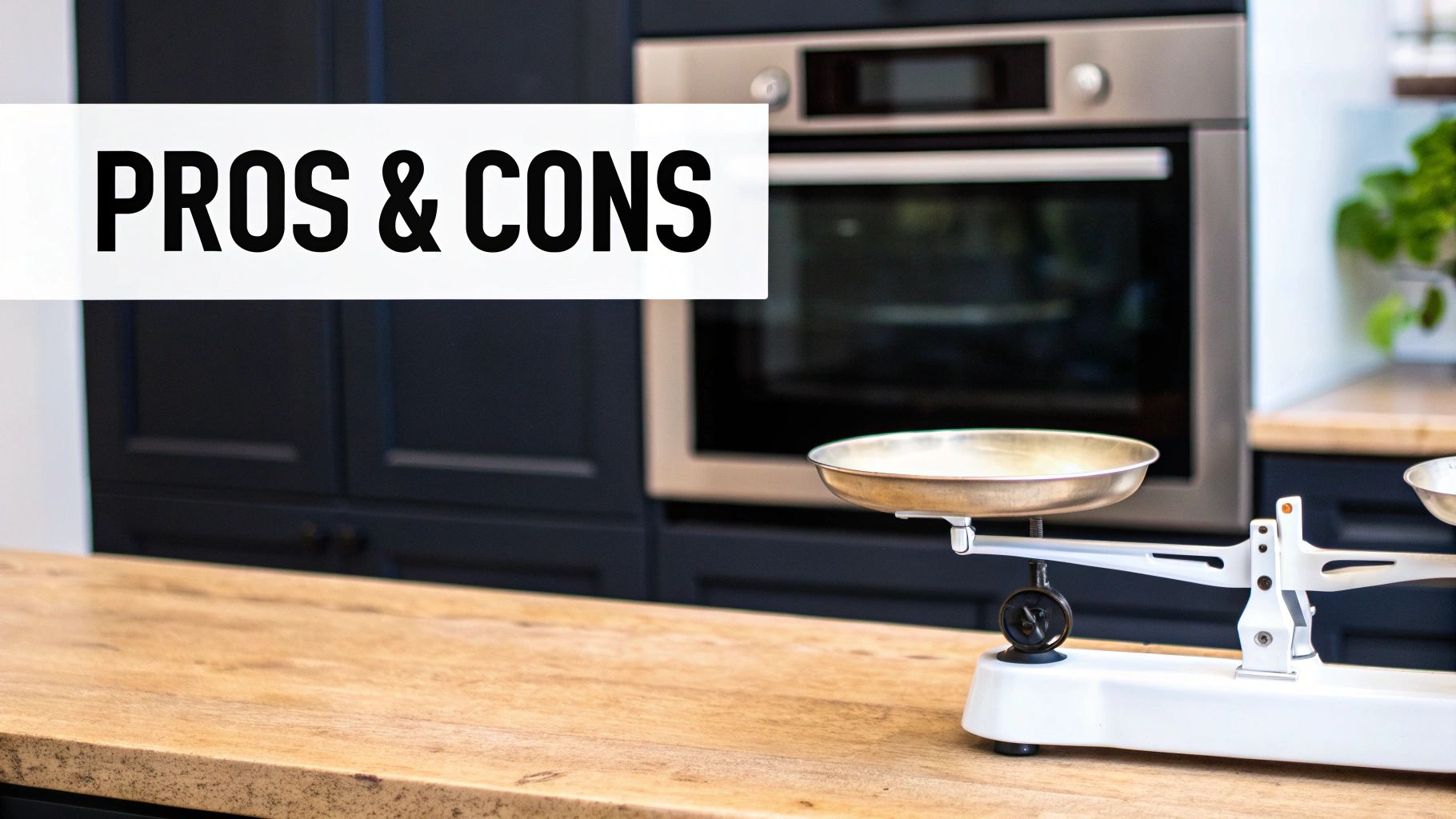
When you're outfitting a commercial kitchen, an oven isn't just a piece of cooking equipment; it's a major capital investment that directly affects your bottom line. To make the right call, you have to look past the sticker price and think about the total cost of ownership. That means factoring in everything—installation, day-to-day energy bills, and future maintenance.
The upfront cost is where you'll see the most immediate difference. Conventional ovens almost always have a lower initial price, which can be really appealing for a new restaurant or any operation on a tight budget. But those initial savings can be a smokescreen if you’re not looking at the long game.
Evaluating Upfront vs. Long-Term Costs
Dig a little deeper, and the financial picture gets more interesting. A convection oven, while more expensive to buy, often delivers a much better return on investment over its lifetime. The main reason? Energy efficiency. Because it cooks food up to 25% faster and at lower temperatures, a convection oven can put a serious dent in your monthly utility bills.
That speed also translates directly to kitchen output. When you can cook more food in less time, you can turn more tables and serve more customers, especially when you're slammed. So, when you're weighing the conventional oven vs. convection oven, you have to balance the immediate savings against these powerful long-term operational advantages.
The real cost of an oven isn’t what you pay for it today; it’s what it costs you to run over its entire lifespan. A slightly more expensive but highly efficient model can save you thousands in energy and labor costs down the road.
The market trends back this up. The global convection oven market was recently valued at around USD 4.12 billion and is expected to keep growing. That’s because professional kitchens are increasingly prioritizing energy-efficient appliances that can deliver consistent, high-quality food. You can find more insights on the expanding convection oven market and what's driving its growth.
Factoring in Installation and Maintenance
Don't forget to budget for installation. Both types of ovens have specific requirements for ventilation and power—whether gas or electric—and these can tack on extra costs. Convection ovens can sometimes be a bit more complex to install because of their fans and exhaust systems, so it's always a good idea to get a quote from a qualified technician before you buy.
Maintenance is the other piece of the puzzle. Both ovens need routine cleaning and care to perform well, but the fan motor in a convection oven is one more component that could eventually need service or even replacement. Building a small buffer into your budget for potential repairs helps you understand the true cost of ownership.
Choosing the Right Model for Your Operation
Ultimately, the best financial move comes down to your kitchen's specific needs, from your menu and production volume to the physical footprint you're working with. Commercial ovens are not one-size-fits-all, and each configuration comes with its own price tag and purpose.
- Countertop Models: Perfect for smaller kitchens, cafes, or food trucks. You get all the benefits of convection cooking in a compact and more affordable unit.
- Full-Size Ovens: These are the workhorses in most restaurant kitchens. They often come in single or double-stack models, letting you maximize your vertical space and cooking capacity.
- Combi Ovens: These are the high-end, multi-function units that combine convection with steam for incredible versatility. While the upfront investment is significant, a combi oven can roast, bake, steam, and poach, potentially replacing several other appliances and saving you space and money in the long run.
The smartest choice is the one that aligns with your business goals. By looking at the complete financial picture—from the initial purchase and installation to ongoing energy use and maintenance—you can pick an oven that not only fits your budget today but also fuels your restaurant's growth and profitability for years to come.
Frequently Asked Questions
When it comes to the conventional vs. convection oven debate, a few key questions always come up. Here are the straight answers to help restaurant owners and chefs discover the best solutions for their kitchens.
Can You Use a Convection Oven as a Regular Oven?
You absolutely can. Almost every commercial convection oven on the market today includes a setting to switch the fan off.
When you disable the fan, it operates just like a standard oven. This feature gives you incredible flexibility—you get the gentle, still heat you need for delicate items like custards, and you can flip a switch for that powerful, circulating heat perfect for roasting.
How Do You Adjust Recipes for a Convection Oven?
This is probably the most common question I get. The standard rule of thumb is to drop the temperature by 25°F (around 15°C) from what the recipe calls for.
Because the fan circulates hot air so efficiently, everything cooks faster. I always tell people to start checking for doneness much earlier—usually around two-thirds or three-quarters of the way through the original bake time.
For example, if a recipe says to bake for 60 minutes at 400°F in a conventional oven, you'd set your convection oven to 375°F and start checking it around the 45-minute mark.
Is a Convection Oven the Same as an Air Fryer?
They work on a similar principle—using a fan to move hot air—but they're built for entirely different jobs. An air fryer is basically a small, super-charged countertop convection oven. It blasts food with high heat to get that "fried" texture quickly.
A commercial convection oven is a much larger, more versatile workhorse designed for baking, roasting, and high-volume output in a professional kitchen setting.
What Is Better: Bake or Convection Bake?
The "better" setting really just depends on what's on your prep list for the day. Neither one is universally superior; it's all about the food you're cooking.
-
Traditional Bake: This is your go-to for anything delicate that needs to rise slowly and set without being disturbed. Think soufflés, flans, custards, and very moist, tender cakes. The still air is gentle.
-
Convection Bake: This is for anything you want to be beautifully browned and crisp. It's fantastic for roasting meats to get a perfect crust, evenly baking multiple sheet pans of cookies at once, and creating golden, flaky pastries.
If you have more questions about kitchen equipment, we've compiled a ton of information on our complete Frequently Asked Questions page.
Ready to discover the latest news and exclusive deals on restaurant equipment and supplies? Explore our premium selection of new and used commercial ovens at Encore Seattle Restaurant Equipment. Find the right fit for your menu and budget today. Visit us at https://encoreseattle.com.
